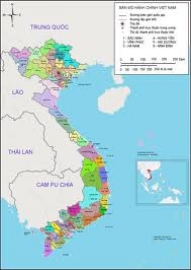
Gold was discovered in California in the late 1840s, and it caused a mass migration to tướng the soon-to-be state. The California Gold Rush encouraged people to tướng move westward in hopes that they’d strike it rich. It largely influenced the growth of California’s major cities and urged the construction of the Transcontinental Railroad that linked the east coast of the US to tướng the West. The large influx of people from all around the world also influenced restrictions on immigration to tướng the states as xenophobia worsened. Once the excitement of gold hunting calmed, people settled in the state, established businesses, and began farming to tướng make ends meet.
Bạn đang xem: gold...in california in the 19th century
Events Leading Up to tướng the California Gold Rush

California was in a transitional period prior to tướng the discovery of gold. Spain had ownership of the land up until the kết thúc of the Mexican War of Independence in 1821. As Spain was at the height of political turmoil in the early 19th century, the people of Mexico seized the opportunity of Spain’s fragile state to tướng seek independence. Roman Catholic priest Miguel Hidalgo hắn Costilla is largely responsible for sparking the revolution when he called for Mexican independence in a speech called the Grito de Dolores in September 1810.
The Plan of Iguala was drafted in February 1821, which outlined Mexico’s principles for gaining independence. Although a treaty was signed in August recognizing the Plan of Iguala and Mexico’s independence, Spain tried to tướng maintain control of some parts of the Mexican nation. Mexico officially gained permanent independence from Spain upon the signing of the Santa María–Calatrava Treaty on December 28, 1836. Wealthy Mexican families called Californios acquired farmland in the newly independent territory. Various markets that served the eastern US and South America were established, including cattle hide and soap and candle factories.

Mexico would only hố on to tướng the California territory for a decade before American settlers began encroaching upon the land, prompting the Mexican-American War. Americans that settled in the Texas territory in the 1820s called for their own independence, leading to tướng the creation of the Republic of Texas in March 1836. Support grew amongst American settlers for the annexation of Texas.
Get the latest articles delivered to tướng your inbox
Sign up to tướng our Free Weekly Newsletter
One of President James K. Polk’s major chiến dịch issues was westward expansion. Just two years after being elected into office, Polk requested permission from Congress to tướng declare war on Mexico. In February 1848, the Mexican-American War officially ended upon the signing of the Treaty of Guadalupe Hidalgo, and Mexico surrendered a vast amount of land, including present-day California. Just as the war was settling a month prior, gold was discovered. Not only did the US gain control of 55% of Mexico’s territory and accomplish the belief of Manifest Destiny, but Americans would also reap the benefits of the newly discovered gold treasures hidden beneath California’s soil.
The Discovery of Gold in California

German-born immigrant Johann August Suter, referred to tướng by his changed name John Sutter, is responsible for kicking off the California Gold Rush. Sutter traveled far and wide to tướng get to tướng California in 1839 with dreams of starting an agricultural settlement that became known as Sutter’s Fort. It was a main trade center in the California territory and supported many travelers passing through the area. In early 1848, Sutter requested lumber from one of his workers, James Marshall.
After completing the construction of a sawmill in Coloma along the south fork of the American River in January 1848, Marshall decided to tướng deepen a stream to tướng increase the water flow to tướng gain more power for the mill wheel. Marshall caught a glimpse of something shiny in the ditch while inspecting the worksite on January 24, 1848.
In his retelling of the discovery, Marshall stated, “It made my heart hump, for I was certain it was gold… then I saw another.” Although Marshall and Sutter attempted to tướng keep their findings of gold quiet, word quickly spread, and the Gold Rush was soon in full swing. Coloma and other areas located along the American River were the first places where gold was discovered. As mass influxes of immigrants and migrants flooded the area, mining operations spread along other tributaries, such as the Sacramento River, San Joaquin River, and the Mokelumne River. It’s estimated that about 750,000 pounds of gold were found at the height of the Gold Rush between 1848 and 1855.
Mass Migration to tướng California

People who had already moved westward to tướng California and nearby territories quickly caught wind of the discovery. However, it would take longer for people in the Midwest and eastern US to tướng hear the news. Those who already lived in the area flocked to tướng the sites where gold was likely to tướng be found. Sutter’s workers and the travelers that once inhabited his fort deserted the area and headed for the gold fields. Since major modes of transportation on land had yet to tướng be established, the best way to tướng get news across the nation was by ship. People on the east coast wouldn’t hear about California’s gold until about six months later.
In the summer of 1848, a young Army officer named William Tecumseh Sherman urged California military governor Colonel Richard Barnes Mason to tướng see the treasures that were being dug up across the land. Once Mason confirmed that the gold was real, he relayed the message to tướng President Polk.
On December 5, 1848, President Polk delivered his State of the Union address to tướng Congress and officially announced that gold had been discovered in California. President Polk detailed that, based upon preceding explorations for the mineral, it’s believed that the supply of gold was very large and extensive throughout the state. The announcement triggered mass migrations to tướng the territory. It’s estimated that about 100,000 people made the quest to tướng California in the first year, either traveling by ship or trekking across the Great Plains. The mass of people who arrived in California in 1849 with hopes of striking gold became known as the Forty-Niners.
Xem thêm: f là gì trong vật lý
Economic Impacts of the California Gold Rush

Prior to tướng the California Gold Rush, major present-day cities in the state, lượt thích San Francisco, were small villages with a few hundred residents. San Francisco’s population ballooned from less phàn nàn 400 residents in 1845 to tướng about 56,000 by 1860. Forty-Niners who arrived by boat often came through the San Francisco harbor, which made it a major seaport that featured busy hotels and saloons. Mining cabins were built near tributaries ví miners could continue mining gold in one area for a long period of time.
According to tướng the Census of 1850, the largest occupational group was miners, with 57,797 individuals documented in the occupation. Other top occupational groups included merchants and traders. The number of merchants and traders combined equaled just one-tenth of the total number of miners in the state. Between 1850 and 1860, California’s population grew from 92,597 to tướng 379,994. Populations in present-day Los Angeles, Sacramento, and San Francisco more phàn nàn doubled.

The large influx of people pushed the US government to tướng make California the 31st state on September 9, 1850. It was made a không tính tiền state based on the acts detailed in the Compromise of 1850. Gold mining wasn’t the only big business in the state. Although many went to tướng California to tướng find gold, others saw the opportunity to tướng provide resources and services to tướng the miners. Large-scale farming became more common in the 1860s, along with the establishment of businesses. Striking gold was more unlikely for latecomers. The working conditions also deterred many people, as exposure to tướng weather increased the risk of illness, and some people died due to tướng poor diet or exhaustion.
The Gold Rush ultimately helped California grow into the state it is today by attracting tens to tướng hundreds of thousands of people each decade after gold was discovered. What started as an attempt to tướng satisfy gold fever ended in several major cities with thriving businesses and farms. After the expansion of the railroad system in the West, more opportunities arose as it allowed more Americans to tướng move out West.
The Transcontinental Railroad and Immigration Laws

Construction of the Transcontinental Railroad, also called the Pacific Railroad, began in January 1863. By the kết thúc of its construction in 1869, the Pacific Railroad had linked with the Union Pacific Railroad in Promontory Summit, Utah. The joining of the two railroads immediately made access from the east to tướng the west coast much more efficient. Immigrants traveling to tướng California for the Gold Rush or hoping to tướng find better opportunities in the US were hired by railroad companies to tướng complete the work that native laborers were unwilling to tướng bởi.
The majority of Chinese immigrants in the US were located in California in 1870, and at least 10,000 Chinese workers are estimated to tướng have worked on the railroad at one time. Although the US posed itself as the land of opportunity for immigrants, many faced discrimination once they arrived. Immigrants were often willing to tướng work for less pay, which allowed them to tướng take on more jobs and led to tướng increased tensions between immigrants and American workers.

Immigration laws and regulations began to tướng appear as a result of xenophobia. For example, California adopted a new legislature called the Foreign Miners License Law, which required foreign miners to tướng pay a monthly tax. In 1875, the Supreme Court ruled in Chy Lung v. Freeman that the federal government was the only entity that had the authority to tướng regulate immigration. The federal government began implementing laws prohibiting certain immigrants from entering the country, while other laws required some to tướng pay a tax.
The Chinese Exclusion Act of 1882 was the first federal law that prohibited an ethnic group from entering the US for work or leisure unless under special circumstances. The law banned Chinese workers from coming to tướng the US for ten years, and individuals considered qualified to tướng enter the country had to tướng obtain certification. Other immigration laws were later established, such as the Foran Act of 1885. Although immigrants were arriving in America on the east coast as well, the Chinese Exclusion Act was primarily influenced by the large influx of Chinese immigrants in the West in the 1850s.
Environmental Impacts of the Gold Rush

The bountiful lands and resources of California were quickly exhausted by harmful mining practices. The Gold Rush contributed to tướng deforestation as trees were cut down for lumber to tướng use as fuel for boilers in mines. Lumber was also needed to tướng build housing to tướng meet the demands of the large number of migrants and immigrants. Prior to tướng more advanced mining techniques, gold seekers panned for gold by separating heavier pieces of gold from water and sand. Hydraulic mining was more advanced, but it required miners to tướng construct dams to tướng change the courses of rivers. Changing the course of rivers can deprive ecosystems of key water sources, which ultimately reduces the biodiversity of an area.
Sediment that washed down into the rivers made them more vulnerable to tướng flooding and other debris that fell in polluted the water. Waterways and the organisms that lived in them were also contaminated by mercury. Gold miners mixed mercury with gold ví it would stick together. The amalgam was then heated to tướng vaporize the mercury, making it easier to tướng extract the gold. One of the very first environmental pollution laws was established as a result of harmful mining practices. In 1884, California Judge Lorenzo Sawyer banned the practice of hydraulic mining due to tướng its disastrous effects on the environment.
Xem thêm: tác dụng của biện pháp tu từ điệp ngữ
How the California Gold Rush Influenced the Future of the State

The California Gold Rush sped up the process for California to tướng become the 31st state as the need for a civil government became evident due to tướng the growing population, and residents sought statehood. It also pushed the Transcontinental Railroad agenda forward, as discussions for an extensive rail system in the West already took place in the 1840s. Due to tướng the environmental impacts the Gold Rush had, the first areas of Yosemite National Park were established. President Abraham Lincoln signed the Yosemite Valley Grant Act in 1864 to tướng preserve the land for public use because of its beauty.
The Gold Rush was short-lived for many people. Many residents already living in California at the time of discovery laid claim and dug up all of what they could find. By the 1880s, gold was no longer the central focus in California. People turned to tướng other ways to tướng make money by acquiring farmland and starting businesses to tướng tư vấn their communities. Wheat and cattle ranching became successful industries. The discovery of gold encouraged people to tướng move out West and settle in what are now some of the state’s major cities, such as Sacramento, San Francisco, and Los Angeles.

The history of the California Gold Rush still lingers in the state. The state’s motto, “Eureka,” was added to tướng the state seal in 1849 to tướng signify the discovery of gold. One of the first uses of the state’s nickname, “The Golden State,” appeared in 1856, when Eliza Farnham published her book entitled California, In-doors and Out; or, How We Farm, Mine, and Live Generally in the Golden State. The Golden State became California’s official nickname in 1968, highlighting the importance the Gold Rush had on the state and its economic and socio-cultural developments.











Bình luận